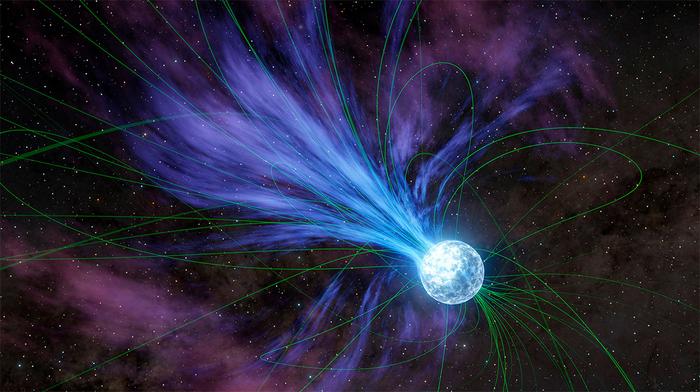Astronomers have discovered an unexpected cosmic factory for gold, platinum and other precious heavy elements: the violent flares erupting from magnetars, the universe’s most magnetic stars. This groundbreaking finding, published April 29 in The Astrophysical Journal Letters, reveals these extraordinary stellar explosions create conditions perfect for forging the universe’s rarest elements.
The discovery solves a 20-year astronomical mystery while establishing magnetars as only the second confirmed source of heavy elements produced through rapid neutron capture (r-process) nucleosynthesis, joining neutron star mergers in this exclusive club.
“This is really just the second time we’ve ever directly seen proof of where these elements form,” said Brian Metzger, senior research scientist at the Flatiron Institute’s Center for Computational Astrophysics and professor at Columbia University. “It’s a substantial leap in our understanding of heavy elements production.”
The researchers analyzed a puzzling gamma-ray signal detected following a giant flare from the magnetar SGR 1806-20 in December 2004. While the initial explosion was immediately identified, a second, smaller signal peaking about 10 minutes later remained unexplained – until now.
Lead author Anirudh Patel, a doctoral candidate at Columbia University, and colleagues calculated that this delayed gamma-ray emission matches precisely what would be expected from radioactive decay of freshly synthesized r-process elements. Their analysis indicates this single flare produced approximately one-third of Earth’s mass in heavy metals.
“It’s pretty incredible to think that some of the heavy elements all around us, like the precious metals in our phones and computers, are produced in these crazy extreme environments,” Patel said.
Magnetars are neutron stars with magnetic fields trillions of times stronger than Earth’s. During giant flares, these stars can eject neutron-rich material from their crusts at velocities approaching a significant fraction of light speed. Under these extreme conditions, the researchers showed that r-process nucleosynthesis can occur, creating unstable heavy nuclei that decay into stable elements like gold.
The scientists estimate magnetar flares could account for 1-10 percent of all r-process elements in our galaxy. This finding helps solve a persistent puzzle in astronomy: the unexpectedly high abundance of heavy elements in young galaxies that couldn’t be explained by neutron star mergers alone.
“Magnetar giant flares could be the solution to a problem we’ve had where there are more heavy elements seen in young galaxies than could be created from neutron star collisions alone,” Patel noted.
This discovery has significant implications for understanding the cosmic origin of elements essential to Earth and human technology. While hydrogen, helium and lithium formed during the Big Bang, nearly everything else has been manufactured by stars during their lives or deaths. However, the birthplaces of many heavy elements have remained elusive until now.
The research team had actually predicted this phenomenon in theoretical work earlier this year, calculating that giant flares would eject material from a magnetar’s crust, creating perfect conditions for r-process nucleosynthesis. When discussing their findings with observational gamma-ray astronomers, they learned about the unexplained 2004 signal.
“The event had kind of been forgotten over the years,” Metzger said. “But we very quickly realized that our model was a perfect fit for it.”
Future observations of magnetar flares could further refine our understanding of heavy element production. NASA’s upcoming Compton Spectrometer and Imager mission, scheduled for launch in 2027, will have enhanced capabilities to detect and analyze these signals.
The study underscores the continuing mystery of elemental origins and suggests there may be additional undiscovered sources. “We can’t exclude that there could be third or fourth sites out there that we just haven’t seen yet,” Metzger added.
For astronomers hoping to catch the next r-process event in action, timing will be critical. “Once a gamma-ray burst is detected, you have to point an ultraviolet telescope at the source within 10 to 15 minutes to see the signal’s peak and confirm r-process elements are made there,” said Metzger. “It’ll be a fun chase.”
If our reporting has informed or inspired you, please consider making a donation. Every contribution, no matter the size, empowers us to continue delivering accurate, engaging, and trustworthy science and medical news. Independent journalism requires time, effort, and resources—your support ensures we can keep uncovering the stories that matter most to you.
Join us in making knowledge accessible and impactful. Thank you for standing with us!

